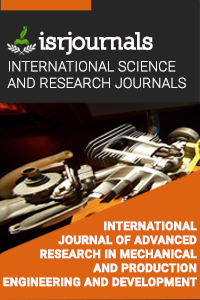multi-response optimization of process parameters influencing electro-mechanical behavior of composite bipolar plates for pem fuel cells
RAGHAVAN.C,KARTHIKEYAN.S,NAVEEN HARRIS RICHARD.A
Published in International Journal of Advanced Research in Mechanical and Production Engineering and Development
ISSN: 2320-7256 Impact Factor:1.398 Volume:2 Issue:1 Year: 14 February,2016 Pages:164-173

Abstract
Proton Exchange Membrane (PEM) fuel cells are considered a promising candidate for zero emission power source required for environmentally friendly transportation applications. Bipolar plate is a multifunctional component within the PEM fuel cell stack and serves the major functions such as providing a uniform distribution of fuel gas and oxygen within the cell, for which the bipolar plates must exhibit excellent electrical conductivity (>100Scm-1) and flexural strength (>25Mpa) as stated by the Department of Energy (DoE, USA). The earlier works carried out with metallic bipolar plates showed poor electrical conductivity (<100Scm-1) and the results obtained by using graphite based bipolar plates showed poor flexural strength (<25Mpa). So the problem of imbalance between these properties is still persisting.. The literature review has not concentrated on optimizing both the properties simultaneously. The focus of this work is to optimize both the properties using the Desirability Function Approach (DFA). Here, the epoxy/activated carbon (50-50 by wt) composite bipolar plate is fabricated using the compression moulding machine. A box behnken experimental design was adopted for the experiment with varying the factors such as Pressure, Temperature and Time. The optimal parameter setting was 130°C, 20 Bar, 30 Minutes for which the values of Flexural strength and Electrical conductivity are 54.1318Mpa and 110.497Scm-1 respectively.
Kewords
Bipolar plates, Multi-response Optimization, Desirability Function
Reference
[1]. Abu Bakar Sulong, Mohd Ikram Ramli, Seow Liang Hau, Jaafar Sahari, Norhamidi Muhammad Hendra Suherman (2013), “Rheological and mechanical properties of carbon nanotube/Graphite/SS316L/polypropylene nanocomposite for a conductive polymer composite”, International journal of composite structure, vol. No. B 50, (2013), pp 54-61. [2]. Biraj Kumar Kakati, Avijit Ghosh, Anil Verma (2012), “Efficient composite bipolar plate reinforced with carbon fibre and graphene for proton exchange membrane fuel cell”,International journal of hydrogen energy, vol. No. 38, (2012), pp: 9362-9369. [3]. Chao Du, Pingwen Ming, Ming Hou, Jie Fu, Yunfeng Fu, Xiaokuan Luo, Qiang Shen, Zhigang Shao, Baolian Yi (2010),“The preparation technique optimization of epoxy/compressed expanded graphite composite bipolar plates for proton exchange membrane fuel cell”, International journal of power source, vol. No. 195, (2010), pp: 5312-5319. [4]. Chao Du, Pingwen Ming, Ming Hou, Jie Fu, Yunfeng Fu, Xiaokuan Luo, Qiang Shen, Zhigang Shao, Baolian Yi (2010), “Preparation and properties of thin epoxy/compressed expanded graphite composite bipolar plates for proton exchange membrane fuel cells”, International journal of power source, vol. No. 195, 2010, pp: 794-800. [5]. Chen Hui, Liu Hong-bo, Yang Li, Li Jian-xin, Yang Li (2009), “Study on the preparation and properties of novolac epoxy/graphite composite bipolar plate for PEMFC”, International Journal Of Hydrogen Energy, Vol. No. 3 5, ( 2 0 1 0 ), pp: 3105-3109. [6]. H.S. Lee, H.J. Kim, S.G. Kim, S.H. Ahn (2007), “Evaluation of graphite composite bipolar plate for PEM (proton exchange membrane) fuel cell: Electrical, mechanical, and moulding properties”, International Journal of Materials Processing Technology, vol. No. 187–188, (2007), pp: 425-428. [7]. J.Jin, S.Leesirisan, M.Song(2010),“Electrical conductivity of ion-doped graphite/Polyethersulphone composites”, International Journal Of Composite Science And Technology, vol. No. 70, (2010), pp: 1544-1549. [8]. Ki Hyun Kim, Jun Woo Lim, Minkook Kim, Dai Gil Lee (2013), “Development of carbon fabric/graphite hybrid bipolar plate for PEMFC”, International journal of composite structure, vol. No. 98, (2013), pp: 103 -110. [9]. Kutlay Sever, Ismail H. Tavman, Yoldas Seki, Alparslan Turgut, Maria Omastova, and Ismail Ozdemir (2013), “Electrical and Mechanical Properties of Expanded Graphite/High Density Polyethylene Nano Composites”, International journal of composites structure, vol. No. B 53, (2013), pp 226 -233. [10]. Min Li, Zhishen Wu, Jinmiao Tan (2012), “properties of form-stable paraffin/silicon dioxide/expanded graphite phase change composites prepared by sol–gel method”,International journal of applied energy, vol. No. 92, 2012, pp: 456-461. [11]. S.R. Dhakate, S. Sharma, N. Chauhan, R.K. Seth, R.B. Mathur (2008) , “CNTs nanostructuring effect on the properties of graphite composite bipolar plate”, International journal of hydrogen energy, vol. No. 3 5, ( 2 0 1 0 ), pp : 4195-4200. [12]. Uk Hwang, Ha Na Yu, Seong Su Kim, Dai Gil Lee, Jung Do Suh, Sung Ho Lee,Byung Ki Ahn, Sae Hoon Kim, TaeWon Lim (2008), “Bipolar plate made of carbon fiber epoxy composite for polymer electrolyte membrane fuel cells”, International Journal Of Power Sources, vol. No. 184, (2008), pp : 90-94. [13]. Xian Jiang, Lawrence T. Drzal (2012), “Exploring the potential of exfoliated graphene nanoplatelets as the conductive filler in polymeric nano composites for bipolar plates”, International journal of power source, vol. No. 218, (2012), pp: 297-306.

